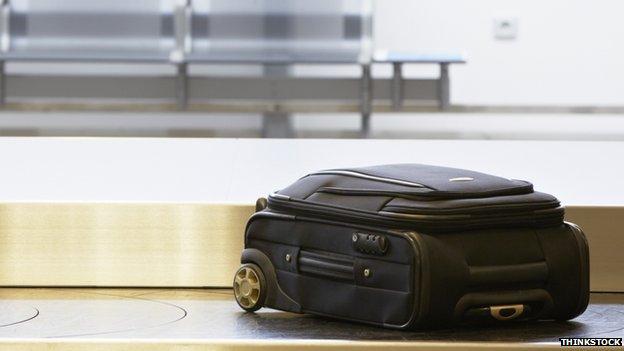Who, What, Why: How is lost luggage found?
- Published

Some passengers jetting away for Easter will inevitably lose their luggage. Why does this happen, and how are passengers reunited with their bags, asks Chris Stokel-Walker.
Holidays are meant to be a break from the stresses of everyday life - unless you're standing at the airport's baggage carousel an hour after your flight touched down, everyone else has left, and you're facing two weeks on the beach with nothing but the clothes you're wearing.
Since 2007, airlines have got better at sending on our luggage to the correct destination. For every 1,000 passengers who fly, there are 7.3 mishandled bags per 1,000 passengers today, compared with 18.9 in 2007. But why do our bags disappear in the first place?
Around half the bags that go missing disappear because of "transfer mishandling" - being moved from one aircraft to another, or across airlines. "Bags don't tend to run as quickly as passengers," notes Nick Gates of SITA, an airline IT company.
This is not the only way bags temporarily disappear. A surprising number make their way to the right destination, but are picked up in error by other passengers. "The world is full of black Samsonite bags," Gates notes.
And what happens once bags disappear?
Passengers tell the airline or airport, and most log the missing bag on World Tracer, a software system used by more than 440 airlines, and other companies dedicated to reuniting lost bags with owners, as well as nearly 3,000 airports.
At the same time, the absent bag usually appears somewhere else in the world - either it didn't make it on to the departing flight, was too slow to make a connection and so is stuck in transit, or was mislabelled and ended up at a totally different airport.
"Eventually it will get found by somebody," says Gates, "and they will report it as being found in the World Tracer system." Tag reference numbers, physical descriptions of the bag and its contents, and other identifying information such as its route before being lost are compared by the system, which then finds a match and reroutes the bag to the owner.
But all the computers in the world don't help in some cases. Natalie Robbie, a London-based actress, was travelling from Gatwick to Edinburgh in July 2014. When she arrived in Scotland, her bag was missing. It didn't turn up on any computer system.
Robbie pestered the bagging handling companies working at both airports. A baggage handler at Gatwick searched the airport's other lost luggage areas, and found the bag in another airline's collection.
"He took the effort to go and look around," Robbie says. "He didn't just look through a computer system."
"It's such a stressful thing," she admits. "You don't realise how crazy it makes you not to have your bag."

The answer
Half of bags go missing when being transferred between planes
Others never make it on to the flight, are mislabelled or just delayed
Airlines typically used software called World Tracer to find bags

Subscribe to the BBC News Magazine's email newsletter, external to get articles sent to your inbox